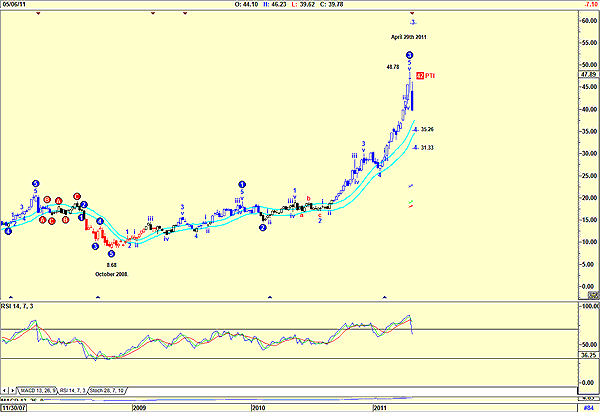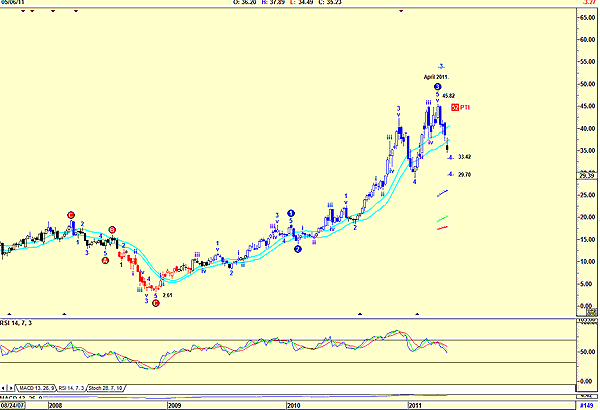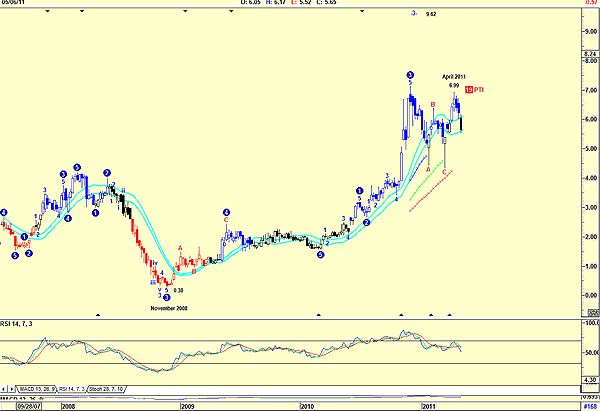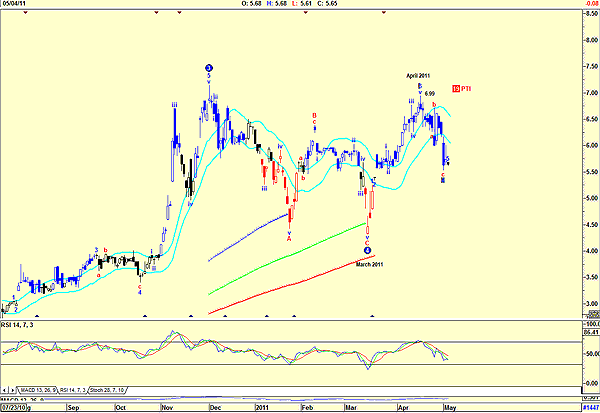
HOT TOPICS LIST
- MACD
- Fibonacci
- RSI
- Gann
- ADXR
- Stochastics
- Volume
- Triangles
- Futures
- Cycles
- Volatility
- ZIGZAG
- MESA
- Retracement
- Aroon
INDICATORS LIST
LIST OF TOPICS
PRINT THIS ARTICLE
by Koos van der Merwe
Is it time to start shouting it again?
Position: Hold
Koos van der Merwe
Has been a technical analyst since 1969, and has worked as a futures and options trader with First Financial Futures in Johannesburg, South Africa.
PRINT THIS ARTICLE
ELLIOTT WAVE
Shouting Silver From The Rooftops?
05/05/11 12:01:02 PMby Koos van der Merwe
Is it time to start shouting it again?
Position: Hold
| I am not an exchange traded fund (ETF) fan because I feel that too many traders play them. The charts below show that I am wrong in my thinking. One would have scored far better playing the ETF than the stock. |

|
| FIGURE 1: i-SHARE SILVER TRUST |
| Graphic provided by: AdvancedGET. |
| |
| Figure 1 is a weekly chart of the iShare Silver Trust ETF. It shows how the ETF moved from a low of $8.68 in October 2008 to a high of $48.78 by April 2011. The Elliott wave count is suggesting that the ETF is now tracing a fourth wave of lesser degree, and it should bottom around the $31.33 to $35.26 level. This is confirmed by the relative strength index (RSI), which is suggesting a sell signal. The PTI (probability index) is 42, which means that the probability of this occurring is 42%. So? Do you buy the iShare Silver Trust when it falls to the $31 or $35 level? Let's face it, the profit from October 2008, had one bought at $8.68 and sold at $48.78 in April 2011, would have been 462%. The chart is suggesting a wave 5 to follow with a target of $70 (not shown), a 100% move should it fall to $35. |

|
| FIGURE 2: SILVER WHEATON |
| Graphic provided by: AdvancedGET. |
| |
| Figure 2, a weekly chart of Silver Wheaton, shows how the price moved from $2.61 in October 2008 to a high of $45.82 by April 2011, a rise of 1,649%, a great deal better than the percentage increase in the iShare Silver Index. The RSI is also bearish, and the PTI suggests a 52% probability that the price will test somewhere between 29.70 and 33.42 before rising to a wave 5 target of $85 (not shown), a 154% return should it fall to and reverse at $33.42. |

|
| FIGURE 3: MINCO SILVER CORP. |
| Graphic provided by: AdvancedGET. |
| |
| Figure 3 is of Minco Silver Corp., which moved from a price of 30 cents in November 2008 to a high of $6.99 by April 2011, a percentage profit of 2,230%. The chart does show a double-top formation with a 19% probability of a fall. The RSI is also bearish, but the wave count on the chart does not show a wave 4 bottom. This is because the PTI is below 32, suggesting that wave 3 is not complete. So can we expect silver to start rising again? |

|
| FIGURE 4: MINCO SILVER CORP., DAILY |
| Graphic provided by: AdvancedGET. |
| |
| A look at the daily chart (Figure 4) shows the double top that has formed at the $7.00 level. The chart also suggests that wave 4 bottomed in March 2011 and that the share is now tracing a wave 2 of wave 5. Once the RSI suggests a buy signal one should buy the share, and definitely choose Minco because the percentage increase could be remarkable. Charts are suggesting that rise of silver is not over, that there could be a final fifth wave rise to new heights. It looks as if shouting about silver from the rooftops will once again be a given. |
Has been a technical analyst since 1969, and has worked as a futures and options trader with First Financial Futures in Johannesburg, South Africa.
| Address: | 3256 West 24th Ave |
| Vancouver, BC | |
| Phone # for sales: | 6042634214 |
| E-mail address: | petroosp@gmail.com |
Click here for more information about our publications!
PRINT THIS ARTICLE

|

Request Information From Our Sponsors
- StockCharts.com, Inc.
- Candle Patterns
- Candlestick Charting Explained
- Intermarket Technical Analysis
- John Murphy on Chart Analysis
- John Murphy's Chart Pattern Recognition
- John Murphy's Market Message
- MurphyExplainsMarketAnalysis-Intermarket Analysis
- MurphyExplainsMarketAnalysis-Visual Analysis
- StockCharts.com
- Technical Analysis of the Financial Markets
- The Visual Investor
- VectorVest, Inc.
- Executive Premier Workshop
- One-Day Options Course
- OptionsPro
- Retirement Income Workshop
- Sure-Fire Trading Systems (VectorVest, Inc.)
- Trading as a Business Workshop
- VectorVest 7 EOD
- VectorVest 7 RealTime/IntraDay
- VectorVest AutoTester
- VectorVest Educational Services
- VectorVest OnLine
- VectorVest Options Analyzer
- VectorVest ProGraphics v6.0
- VectorVest ProTrader 7
- VectorVest RealTime Derby Tool
- VectorVest Simulator
- VectorVest Variator
- VectorVest Watchdog
